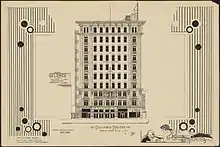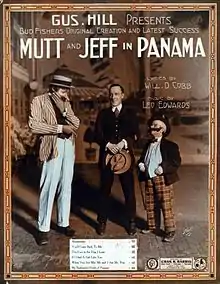Columbia Amusement Company
The Columbia Amusement Company, also called the Columbia Wheel or the Eastern Burlesque Wheel, was an industry organization that produced burlesque shows in the United States between 1902 and 1927. Several dozen Columbia burlesque companies would travel in succession round a "wheel" of theaters, ensuring steady employment for performers and a steady supply of new shows for participating theaters. For much of its history the Columbia Wheel advertised relatively "clean" variety shows featuring comedians and pretty girls. Eventually the wheel was forced out of business due to competition from its one-time subsidiary and eventual rival, the Mutual Burlesque Association, as well as cinemas and cruder stock burlesque companies.
 Columbia Amusement Co. Building, Manhattan, in 1917 | |
| Formation | 12 July 1902 |
|---|---|
| Dissolved | 1927 |
| Legal status | Corporation |
| Purpose | Burlesque booking |
Region | United States and Canada |
Official language | English |
| Leader | Samuel A. Scribner |
| Subsidiaries | American Burlesque Association |
The bottom three floors of the Columbia Amusement Company's building was the Columbia Theatre NYC, the wheel's flagship theater and known to burlesquers and vaudevillians as "The Home of Burlesque Deluxe".
Background
In 1897, burlesque producers and theater managers incorporated the Traveling Variety Managers of America (TVMA) with the purpose of bettering the business of traveling variety managers and for benevolent, literary and fraternal purposes. The directors were Thomas E. Miaco, Henry C. Jacobs and Thomas E. McCready. Among the incorporators were Gus Hill, Phil Sheridan, Frank D. Bryan, George W. Rice and Fred Irwin.[1] The idea was that approved shows would progress from one theater to another in succession, around a "wheel".[2] The vaudeville and burlesque producer Gus Hill claimed credit for the concept.[3]The theaters would not have to compete for shows, and the burlesque companies would have guaranteed work. The TVMA soon split into two wheels, one in the west and the other in the east.[2] The two wheels — the Empire and Columbia — would later merge [1913] under the name Columbia Amusement Company.
Formation

Sixteen managers and producers left the TVMA to set up a more stable operation and incorporated the Columbia Amusement Company on 12 July 1902.[4] The lead was taken by Sam A. Scribner, with other principals William S. Campbell, William S. Drew, Gus Hill, John Herbert Mack, Harry Morris, L. Lawrence Weber and A. H. Woodhill.[5] Headquartered in New York, the circuit included theaters in large cities east of the Missouri and north of the Ohio, such as Washington, D.C., Philadelphia, Pittsburgh, and Cleveland, as well as Toronto and Boston.[6] Since the theaters were in the east, the Columbia Wheel was also called the Eastern Wheel.[5]
Early years
The Columbia organizers at first aimed to provide affordable shows that were acceptable to women as well as men.[5] They advertised "clean" or "refined" burlesque.[7] Shows had multi-act programs that included comedians, skits and variety acts and chorus girls. In August 1905 Will Rogers signed with Columbia for five one-week shows in Brooklyn, New York, Buffalo, Cleveland and Pittsburgh.[8]
Although the wheel system made the industry more stable, the shows became standardized and repetitive. New costumes and acts were expensive, and when performers became better known they often left burlesque for the legitimate theater.[9] Performers who worked in Columbia shows included Weber & Fields, Bert Lahr, W. C. Fields, Rose Sydell, Sophie Tucker, Fanny Brice, and Mollie Williams. Many of them moved into musical comedy or vaudeville as soon as they could.[10] But audiences came to see the girls and burlesque remained profitable.[9]

The Star and Garter opened in Chicago in 1908, providing "Clean Entertainment for Self-Respecting People".[10] On 10 January 1910 the Columbia Amusement Company opened its flagship Columbia Theatre, "Home of Burlesque De Luxe", at Broadway and 47th Street in Manhattan. The theater was designed by William H. McElfatrick and had a capacity of 1,385. The company owned and operated it.[11] The Columbia theater opening was well publicized and was attended by various dignitaries.[10]
Evolution

Meanwhile, the Empire Wheel pushed the legal limits with its shows. Columbia responded by sometimes lowering its standards especially in cities where the two wheels competed directly.[7] In 1913 the two wheels were consolidated into the Columbia Amusement Company, headed by Samuel Scribner and Isidore Herk. Under Scribner's leadership the combined operation put on fairly clean shows.[13] But more titillating stock shows still provided stiff competition, and in 1915 Columbia formed a subsidiary wheel, the American, while keeping Columbia's brand clean. Gus Hill was named president of the new entity[14] and drove competitors out of business.[13]
Although tastes were changing after World War I, Scribner insisted that Columbia shows remain comparatively clean. Although the American Wheel offered cooch dancers performing on runways,[15] Columbia avoided runways until its final years. Scribner, who banned smoking in Columbia circuit theaters, also tried to ban the comedians from using double entendres, but with less success.[16] A 1922 report said "the companies will come to town on the same day each week to offer what is declared to be comedies with music, musical shows with chorus girls or whatever may best describe clean, wholesome offerings that should not be confused with "burlesque" as it was presented when Dad was a young chap."[6]
Decline and dissolution
As Columbia fell behind the times, the American Wheel was dissolved in 1922 due to an argument between Scribner and Herk and replaced by an independent wheel, the Mutual Wheel,[13] headed by Herk.[16] Shows on the Mutual wheel were less elaborate than Columbia's and took inspiration from the riqué revues of Flo Ziegfeld and Earl Carroll.
In 1923 Columbia still had thirty-eight shows on the wheel and was still the largest burlesque operation in the country. However, receipts were declining.[13] By the mid-1920s cinemas were providing shows that combined film and live entertainment with ticket prices lower than any burlesque show.[17] [18]
In the 1925, season Scribner authorized chorus girls, who had worn tights for over twenty years, to perform barelegged, and allowed tableaux of bare-breasted women as seen in Broadway revues. Columbia continued to lose customers to other types of entertainment and to more explicit stock burlesque.[13] Performers and theaters began deserting Columbia and switched to Mutual.[19]
Columbia and Mutual merged in 1927 to form the United Burlesque Association.[18] Herk, became President of the new combination, with Scribner, formerly president of the Columbia Wheel, as the Chairman of the Board.[20] The new organization, comprised 44 theaters,[20] soon reverted to the name Mutual Burlesque.[21][22]
By the 1927–28 season the combined circuit was struggling financially and the Great Depression proved fatal. With smaller, cheaper stock burlesque theaters popping up, the combined wheel decided to revive clean burlesque in 1930-31. The experiment failed, and the circuit closed.[13]
References
Citations
- Poughkeepsie Eagle-News (Poughkeepsie, NY) 'Traveling Variety Managers-New Organization' 23 Jul 1897 Page 2 Column 1.
- Cullen, Hackman & McNeilly 2004, p. 252.
- Cullen, Hackman & McNeilly 2004, p. 510.
- Winchester 1995, p. 16.
- Cullen, Hackman & McNeilly 2004, p. 253.
- Columbia Wheel Shows, Reading Eagle 1922.
- Allen 1991, p. 191-192.
- Dodge & Rogers 2000, p. 183.
- Briggeman 2004, p. 12.
- Wagenknecht 1982, p. 268.
- Columbia Theatre, MCNY.
- Winchester 1995, p. 29.
- Allen 1991, p. 249.
- New Burlesque Circuit, NYT 1915.
- Briggeman 2004, p. 14.
- Shteir 2004, p. 72.
- Allen 1991, p. 244.
- Briggeman 2004, p. 15.
- Shteir 2004, p. 73.
- Buffalo Currier Express, January 15, 1928
- Brooklyn Standard Union August 2, 1929, pg. 8
- Philadelphia Inquirer May 19, 1929, pg 12
Sources
- Allen, Robert Clyde (1991). Horrible Prettiness: Burlesque and American Culture. Univ of North Carolina Press. ISBN 978-0-8078-4316-1. Retrieved 2014-05-14.CS1 maint: ref=harv (link)
- Briggeman, Jane (2004-09-01). Burlesque: Legendary Stars of the Stage. Collectors Press, Inc. ISBN 978-1-888054-94-1. Retrieved 2014-05-14.CS1 maint: ref=harv (link)
- "Columbia Theatre". Museum of the City of New York. Retrieved 2014-05-14.
- "Columbia Wheel Shows". Reading Eagle. 2 October 1922. Retrieved 2014-05-14.
- Cullen, Frank; Hackman, Florence; McNeilly, Donald (2004). "Gus Hill". Vaudeville old & new: an encyclopedia of variety performances in America. Psychology Press. ISBN 978-0-415-93853-2.CS1 maint: ref=harv (link)
- Dodge, Richard Irving; Rogers, Will (2000). The Indian Territory Journals of Colonel Richard Irving Dodge. University of Oklahoma Press. ISBN 978-0-8061-3267-9. Retrieved 2014-05-14.CS1 maint: ref=harv (link)
- "New Burlesque Circuit". New York Times Article. 10 May 1915.
- Shteir, Rachel (2004-11-01). Striptease : The Untold History of the Girlie Show: The Untold History of the Girlie Show. Oxford University Press. p. 72. ISBN 978-0-19-802935-9. Retrieved 2014-05-14.CS1 maint: ref=harv (link)
- Wagenknecht, Edward (1982). American Profile, 1900–1909. Univ of Massachusetts Press. p. 268. ISBN 0-87023-351-3. Retrieved 2014-05-14.CS1 maint: ref=harv (link)
- Winchester, Mark David (1995). "Cartoon Theatricals from 1896 to 1927: Gus Hill's Cartoon Shows for the American Road Theatre". Ohio State University. Retrieved 2014-05-13.CS1 maint: ref=harv (link)
